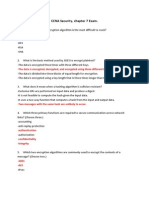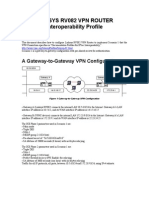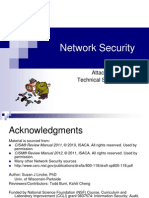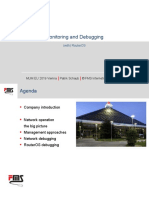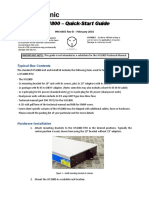0 ratings0% found this document useful (0 votes)
241 viewsCcna Notes
Ccna Notes
Uploaded by
Ahmad AliNTP uses a hierarchy of stratums to synchronize time accuracy, with stratum 0 being the most accurate like GPS or atomic clocks. Cisco routers can take on different roles in an NTP network like server, client, or peer. They can operate at stratum 8 when synchronized or 16 when unsynchronized. Root Guard is configured at the port level and prevents switches downstream from becoming the root or secondary root, instead placing the port in a root-inconsistent state until superior BPDUs stop coming in. Authentication verifies if a user should access the network, and VPNs allow private and secure connections between endpoints like different company sites through tunnels. Configuring a site-to-site VPN is a five-step process involving
Copyright:
© All Rights Reserved
Available Formats
Download as TXT, PDF, TXT or read online from Scribd
Ccna Notes
Ccna Notes
Uploaded by
Ahmad Ali0 ratings0% found this document useful (0 votes)
241 views2 pagesNTP uses a hierarchy of stratums to synchronize time accuracy, with stratum 0 being the most accurate like GPS or atomic clocks. Cisco routers can take on different roles in an NTP network like server, client, or peer. They can operate at stratum 8 when synchronized or 16 when unsynchronized. Root Guard is configured at the port level and prevents switches downstream from becoming the root or secondary root, instead placing the port in a root-inconsistent state until superior BPDUs stop coming in. Authentication verifies if a user should access the network, and VPNs allow private and secure connections between endpoints like different company sites through tunnels. Configuring a site-to-site VPN is a five-step process involving
Original Description:
CCNA Notes
Copyright
© © All Rights Reserved
Available Formats
TXT, PDF, TXT or read online from Scribd
Share this document
Did you find this document useful?
Is this content inappropriate?
NTP uses a hierarchy of stratums to synchronize time accuracy, with stratum 0 being the most accurate like GPS or atomic clocks. Cisco routers can take on different roles in an NTP network like server, client, or peer. They can operate at stratum 8 when synchronized or 16 when unsynchronized. Root Guard is configured at the port level and prevents switches downstream from becoming the root or secondary root, instead placing the port in a root-inconsistent state until superior BPDUs stop coming in. Authentication verifies if a user should access the network, and VPNs allow private and secure connections between endpoints like different company sites through tunnels. Configuring a site-to-site VPN is a five-step process involving
Copyright:
© All Rights Reserved
Available Formats
Download as TXT, PDF, TXT or read online from Scribd
Download as txt, pdf, or txt
0 ratings0% found this document useful (0 votes)
241 views2 pagesCcna Notes
Ccna Notes
Uploaded by
Ahmad AliNTP uses a hierarchy of stratums to synchronize time accuracy, with stratum 0 being the most accurate like GPS or atomic clocks. Cisco routers can take on different roles in an NTP network like server, client, or peer. They can operate at stratum 8 when synchronized or 16 when unsynchronized. Root Guard is configured at the port level and prevents switches downstream from becoming the root or secondary root, instead placing the port in a root-inconsistent state until superior BPDUs stop coming in. Authentication verifies if a user should access the network, and VPNs allow private and secure connections between endpoints like different company sites through tunnels. Configuring a site-to-site VPN is a five-step process involving
Copyright:
© All Rights Reserved
Available Formats
Download as TXT, PDF, TXT or read online from Scribd
Download as txt, pdf, or txt
You are on page 1of 2
NTP is set up as a hierarchy, and the levels/layers are called stratums.
The lower the number, the more accurate the time.
Top stratum layer is 0-those are GPS clocks or atomic clock.
Cisco routers cannot serve a stratum 0 devices.
Cisco routers can take on one of there roles in out NTP network Server, client,
peer.NTP use UDP port 123.By default, cisco rotuer take 8 stratums when NTP is
sychronized when unsynchronized 16 stratums.
0-Emergencies (Lot of trouble)
1-Alerts (Take care of this now)
2-Critical (Really Important)
3-Errors (Should know about this)
4-Warnings (You have to know about this)
5-Notifications (Look at this )
6-Information (Interesting)
7-Debugging (Stuff behind commands)
Root Guard is configured at the port level, and disqualifies any switch
downstream from that port from becoming the root OR secondary root.
The port is not disabled but placed into root-inconsistent state. When those
superior BPDUs stop coming in, the port will return to normal operation.
Authenication is the process of deciding of a given user should be allowed to
access the network or a network serivce in the first place.
time-rang <Name-of-Time)
vpn
Virtual -Doesn't exist physically, its a tunnel between two endpoints
Private- open only to the two parties at the endpoints
Network- its a network
VPN are basically a point to point WAN
A site-to-site VPN allows users at one compnay site to connect securely to anoth
er company site.
VPN good points are Scalability, cost and Security
Authentication: ciphers and keys
Data Integrity: hashes
Confidentiality:
there are two major classess of encryption algorithms Asymmetric & Symmetric
Symmetric uses one single key for both encryption and decryption. In VPN only go
ing to take place if both ends possess the key.Faster than asymmetric.
Symmetric algorithms includes DES,3DES, AES,RC4,Blowfish and IDEA.
Aysmmetric uses one key to encrypt data and a separate key to decrypt the same d
ata. One key is the public key and the other is private key.Aysmmetric algorithm
s includes Diffie-Hellman,RSA, DSS.
RSA uses two keys one public and other private key, Slow operation
DES is the key size its only 56 bits
IPSec short for IP Security, IPSec allows use to authenticate encrypt every IP p
acket in a particular data stream.Runs at layer 3.IPSec uses checksums and hashi
ng algorithms such as MD5 and SHA1 to assure data integrity.
Authentication Header (AH), defines a method for authencation and securing data.
AH doesnt provide data confidentiality
Encapsulating Security Payload (ESP), defines a method for authencating, securit
y and encrypting data. provide data confidentiality
Internet Key Echange (IDE), negotiates the security parameters and authenticatio
n keys
Configuring a site-to-site VPN is a five-step process:
Process initializaiton via intresting traffic
IKE Phase 1 (IKE SA Negotiation)
IKE Phase 2 (IPSec SA Negotiation)
Data Transfer
Tunnel Termination
You might also like
- COmputer SecurityDocument11 pagesCOmputer SecurityJerry ONo ratings yet
- Presentation Ms PaladiumDocument19 pagesPresentation Ms PaladiumSudhanshu SinghNo ratings yet
- VPNDocument9 pagesVPNahmed.matrix95.m16No ratings yet
- 4990 - Configuration of An Ipsec VPN Server On Rv130 and Rv130wDocument12 pages4990 - Configuration of An Ipsec VPN Server On Rv130 and Rv130wKhadija Khadija AouadiNo ratings yet
- Virtual Private Network (VPN) : IpsecDocument4 pagesVirtual Private Network (VPN) : Ipsecabhineet sharmaNo ratings yet
- IMPLEMENTATION OF Mc-ELIECE QUANTUM CRYPTO-SYSTEM ON FPGA FOR WIRELESS SENSOR NETWORKSDocument74 pagesIMPLEMENTATION OF Mc-ELIECE QUANTUM CRYPTO-SYSTEM ON FPGA FOR WIRELESS SENSOR NETWORKSLakshman PadmashaliNo ratings yet
- NSC Unit - 2 - 221218 - 100752Document25 pagesNSC Unit - 2 - 221218 - 100752SurenderNo ratings yet
- First Phase Basic Network Security Interview QuestionsDocument5 pagesFirst Phase Basic Network Security Interview QuestionslakshminarayanvasudevsNo ratings yet
- Symmetric Keys Can Be Used To Both Encrypt and Decrypt Data. More Specifically, The SameDocument11 pagesSymmetric Keys Can Be Used To Both Encrypt and Decrypt Data. More Specifically, The SameRahulNo ratings yet
- Mikrotik IpsecDocument13 pagesMikrotik IpsecMertol SerbanNo ratings yet
- If You Have To Both Encrypt and Compress Data During Transmission, Which Would You Do First, and Why?Document20 pagesIf You Have To Both Encrypt and Compress Data During Transmission, Which Would You Do First, and Why?Pallavi BhartiNo ratings yet
- Connection SecurityDocument52 pagesConnection SecurityQuangHuyĐoànNo ratings yet
- 595 Assesment 3Document10 pages595 Assesment 3chanpreetNo ratings yet
- Weak and Semi-Weak Keys in DESDocument10 pagesWeak and Semi-Weak Keys in DESAbdulrahman Radeef100% (1)
- IP SecurityDocument10 pagesIP Securitypray71No ratings yet
- An Illustrated Guide To IPsecDocument19 pagesAn Illustrated Guide To IPsecwouterNo ratings yet
- Computing With Encrpted DataDocument18 pagesComputing With Encrpted DataSushant BhardwajNo ratings yet
- IP Security OverviewDocument16 pagesIP Security OverviewlukastoniNo ratings yet
- Mikrotik IpsecDocument13 pagesMikrotik IpsecMertol SerbanNo ratings yet
- CCNA Security Ch07 Quiz AnswersDocument6 pagesCCNA Security Ch07 Quiz Answersdercole69No ratings yet
- Snort - Inline As A Solution: ProgrammingDocument11 pagesSnort - Inline As A Solution: Programming'Sami SneijderNo ratings yet
- How To Create A VPN Server Using SDMDocument13 pagesHow To Create A VPN Server Using SDMMitu SwainNo ratings yet
- DCOM 258 Lab 13 Encryption & Hashing ConceptsDocument6 pagesDCOM 258 Lab 13 Encryption & Hashing ConceptsShaamim U AhmedNo ratings yet
- CCNAS Chapter 7Document6 pagesCCNAS Chapter 7angela_maria_rNo ratings yet
- IPSec VPN OverviewDocument9 pagesIPSec VPN OverviewJoão Manuel SebastiãoNo ratings yet
- CISSP CryptographyDocument1 pageCISSP Cryptographyonlysubas100% (1)
- Snort - Inline As A SolutionDocument11 pagesSnort - Inline As A SolutiondasxaxNo ratings yet
- Password Attacks PDFDocument32 pagesPassword Attacks PDFtewsttesreNo ratings yet
- MCQS - Cs 707 Paper-SolvedDocument21 pagesMCQS - Cs 707 Paper-SolvedShahid AzeemNo ratings yet
- CryptographyDocument23 pagesCryptographyAnubhav KumarNo ratings yet
- Responses 1Document25 pagesResponses 1CiaraNo ratings yet
- Notes On LonWorks-1Document8 pagesNotes On LonWorks-1mughees_itcompNo ratings yet
- Serpent and Smartcards: Abstract. We Proposed A New Block Cipher, Serpent, As A Candidate ForDocument8 pagesSerpent and Smartcards: Abstract. We Proposed A New Block Cipher, Serpent, As A Candidate ForAKISNo ratings yet
- Assignment - 3: Name: J Yeshwanth Gopal Roll No:1210716114 SEC:C1Document10 pagesAssignment - 3: Name: J Yeshwanth Gopal Roll No:1210716114 SEC:C1sololifeNo ratings yet
- Hardening Linux Web ServersDocument22 pagesHardening Linux Web Serversairamorr100% (1)
- SNORTNEWDocument23 pagesSNORTNEWjayshreeNo ratings yet
- ?Cyber Questions?️Document7 pages?Cyber Questions?️familbnb00No ratings yet
- Original ProjectDocument65 pagesOriginal ProjectChaitanya SunkaraNo ratings yet
- 1 (A) Explain The Static and Dynamic Routing Protocols? #Static RoutingDocument10 pages1 (A) Explain The Static and Dynamic Routing Protocols? #Static RoutingAtik Israk Lemon100% (1)
- Cap 8Document19 pagesCap 8Wylliam GongoraNo ratings yet
- SOC2Document20 pagesSOC2The AnonymousNo ratings yet
- Ciphersuite Analysis and Strong Cipher Enablement - 0Document24 pagesCiphersuite Analysis and Strong Cipher Enablement - 0Kali LNo ratings yet
- Advanced Security Encryption Key Programming Guide For Latticeecp2S, Latticeecp2Ms, and Latticeecp3 DevicesDocument22 pagesAdvanced Security Encryption Key Programming Guide For Latticeecp2S, Latticeecp2Ms, and Latticeecp3 Deviceschengchung liNo ratings yet
- AESDocument67 pagesAESRama VenkateshNo ratings yet
- Tor Protocol SpecificationDocument42 pagesTor Protocol SpecificationAZERTYUIOPNo ratings yet
- DCN Unit 7Document40 pagesDCN Unit 7RazinNo ratings yet
- Tor Protocol Specification 2Document42 pagesTor Protocol Specification 2AZERTYUIOPNo ratings yet
- Experiment No.5 - Cyber SecurityDocument10 pagesExperiment No.5 - Cyber SecurityNIRANJAN KALENo ratings yet
- CCNP Questoues Que Eerrei Simulado Segunda VezDocument7 pagesCCNP Questoues Que Eerrei Simulado Segunda VezJadson RodriguesNo ratings yet
- Presented By: Kulwinder Priyanka PriyaDocument70 pagesPresented By: Kulwinder Priyanka PriyaPriya RainaNo ratings yet
- No Network Is 100Document7 pagesNo Network Is 100AngelDayanaNo ratings yet
- ProjectDocument21 pagesProjectChandan Kumar100% (1)
- IPsec Troubleshooting Understanding and Using Debug CommandsDocument17 pagesIPsec Troubleshooting Understanding and Using Debug CommandsVineeth KanthareddyNo ratings yet
- What Is CryptographyDocument9 pagesWhat Is CryptographySagar DixitNo ratings yet
- Linksys Rv082 VPN Router Interoperability Profile: C o M C OmDocument11 pagesLinksys Rv082 VPN Router Interoperability Profile: C o M C OmhackergenomaNo ratings yet
- Evaluation & Testing of Information AssetsDocument10 pagesEvaluation & Testing of Information AssetsMaksNo ratings yet
- Take Assessment 7Document12 pagesTake Assessment 7Titto ThomasNo ratings yet
- Sysnet Notes: Basic CCNA Interview Questions AND AnswersDocument8 pagesSysnet Notes: Basic CCNA Interview Questions AND AnswersReddy SumanthNo ratings yet
- Site-To-Site Vpns. - : Scor Page 1Document14 pagesSite-To-Site Vpns. - : Scor Page 1Ahmad AliNo ratings yet
- Cybersecurity Fundamentals: Threat.Document17 pagesCybersecurity Fundamentals: Threat.Ahmad AliNo ratings yet
- Wireshark User's GuideDocument334 pagesWireshark User's GuideAhmad AliNo ratings yet
- 200 Networking Interview QuestionsDocument50 pages200 Networking Interview QuestionsAngel Simo MoralesNo ratings yet
- Carey Williamson Icore Chair and Professor Department of Computer Science University of CalgaryDocument8 pagesCarey Williamson Icore Chair and Professor Department of Computer Science University of CalgaryAhmad Ali100% (1)
- Diff Rence RoutingDocument3 pagesDiff Rence RoutingAhmad AliNo ratings yet
- Syn Flood Attack With Hping3Document1 pageSyn Flood Attack With Hping3Ahmad AliNo ratings yet
- Network SecurityDocument59 pagesNetwork SecurityAhmad AliNo ratings yet
- CCNDocument1 pageCCNAhmad AliNo ratings yet
- Common ErrorsDocument1 pageCommon ErrorsAhmad AliNo ratings yet
- Mikrotik y WiresharkDocument60 pagesMikrotik y WiresharkYrmaleza de RomeroNo ratings yet
- Nortel Passport 8000/ Accelar: Supports Management Module SM-NTL1003Document83 pagesNortel Passport 8000/ Accelar: Supports Management Module SM-NTL1003Luis RodriguesNo ratings yet
- Wireless Ad-Hoc NetworksDocument2 pagesWireless Ad-Hoc Networkskandasamy ANo ratings yet
- Itu - H.323Document108 pagesItu - H.323Roberto MontagnanaNo ratings yet
- 4A0-M01 Alcatel-Lucent IP MPLS Mobile Backhaul Transport ExamDocument79 pages4A0-M01 Alcatel-Lucent IP MPLS Mobile Backhaul Transport ExamAshleyNo ratings yet
- NT1330: Client-Server Networking 2 Lesson 5: Active Directory AdministrationDocument2 pagesNT1330: Client-Server Networking 2 Lesson 5: Active Directory AdministrationNichole BanksNo ratings yet
- How To Guide FortiGate Sizing GuideDocument5 pagesHow To Guide FortiGate Sizing Guidemdenis78No ratings yet
- Indian Railways Summer Training: Presented By: Kapileshwar Ec-A 1206431047Document21 pagesIndian Railways Summer Training: Presented By: Kapileshwar Ec-A 1206431047PranjalNo ratings yet
- Hosting ErDocument6 pagesHosting ErBrylle MatalinesNo ratings yet
- Expt 1Document4 pagesExpt 1ashtoshNo ratings yet
- CCNP Switch V7.1 Quiz - Chapter 5: Intervlan Routing and DHCPDocument8 pagesCCNP Switch V7.1 Quiz - Chapter 5: Intervlan Routing and DHCPjohnNo ratings yet
- B-Bng-Cg53xasr9k Chapter 01110Document16 pagesB-Bng-Cg53xasr9k Chapter 01110Marco CocchiNo ratings yet
- Cyber Security HandbookDocument76 pagesCyber Security HandbookDon William100% (1)
- E-Commerce-Website-Project: U1@polito - It U1@polito - ItDocument2 pagesE-Commerce-Website-Project: U1@polito - It U1@polito - Itshahim akramNo ratings yet
- Testing With N2XDocument8 pagesTesting With N2XNguyễn Trần TuấnNo ratings yet
- Sonicwall™ Nsa 2600/3600/4600/5600/6600: Getting Started GuideDocument63 pagesSonicwall™ Nsa 2600/3600/4600/5600/6600: Getting Started GuideTarun BhatnagarNo ratings yet
- Enterprise (IPX-9200) IPSTAR Satellite Terminal User Guide 1.0Document25 pagesEnterprise (IPX-9200) IPSTAR Satellite Terminal User Guide 1.0Kyaw KyawNo ratings yet
- ACN Micro Project-1Document23 pagesACN Micro Project-1ashutosh dudhaneNo ratings yet
- Forecasting YouTube QoE Over SATCOMDocument6 pagesForecasting YouTube QoE Over SATCOMAhmed EJNo ratings yet
- GV20 Command ListDocument9 pagesGV20 Command ListenriqueiturraNo ratings yet
- FK Show Led - 20141219testDocument215 pagesFK Show Led - 20141219testEdo AntonioNo ratings yet
- WS1800 - Quick-Start Guide: 994-0005 Rev B - February 2016Document4 pagesWS1800 - Quick-Start Guide: 994-0005 Rev B - February 2016blanoswa11No ratings yet
- Explanation: Frequency Hopping Spread Spectrum (FHSS) Systems Use Frequency Diversity (ChangingDocument28 pagesExplanation: Frequency Hopping Spread Spectrum (FHSS) Systems Use Frequency Diversity (Changingyerima1No ratings yet
- Filtering Out SpamDocument64 pagesFiltering Out SpamAdrian AdrNo ratings yet
- CSC-MASTER-VER 6.0 CIS Critical Security Controls 10.15.2015Document94 pagesCSC-MASTER-VER 6.0 CIS Critical Security Controls 10.15.2015James Cameron CuppsNo ratings yet
- Brkopt 2699Document83 pagesBrkopt 2699AngryGoat04No ratings yet
- GS1900-8 Firmware 2.60 (AAHH.2) C0Document10 pagesGS1900-8 Firmware 2.60 (AAHH.2) C0Din CessareNo ratings yet
- VMware Basic Functional TestsDocument6 pagesVMware Basic Functional Testsashu_dwi2002No ratings yet
- Configuring VPC Virtual Port Channel With Cisco Nexus: Lab TopologyDocument8 pagesConfiguring VPC Virtual Port Channel With Cisco Nexus: Lab TopologyKevin SNo ratings yet
- DLO 9.0 Overview - v2Document17 pagesDLO 9.0 Overview - v2Lucia CastilloNo ratings yet



















